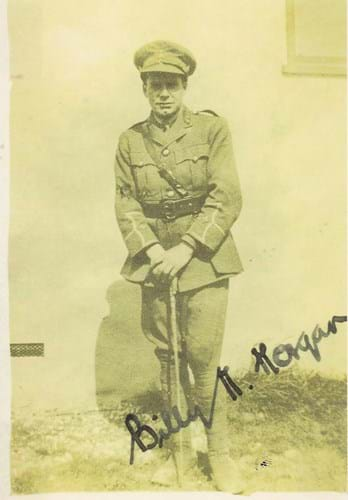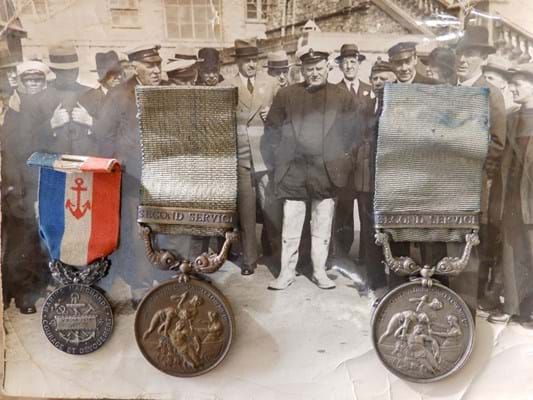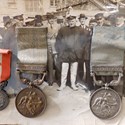Lifeboat coxswain William Mogridge won not just one but two Royal National Lifeboat Institution Medals – a bronze and a silver (with clasps for both denoting a further award of each).
They were sold for £3500 (plus 17.5% buyer’s premium) against an estimate of £700-1000 at the Michael Bowman sale in Newton Abbot on March 25
Mogridge was appointed coxswain of the Torbay Lifeboat in October 1932. On the evening of December 30, 1935, he took the Torbay lifeboat George Shee on a three-hour journey through stormy seas to rescue the one remaining crew member on the French trawler, Satanicle, sinking 15 miles off Start Point. It took a further five hours to return through the heavy seas to Brixham.
The second award of the silver lifeboat medal for gallantry resulted from an incident during which seven lives were saved from the Truro schooner Henrietta, which had been driven onto a reef in a gale.
A tug and a trawler were standing by, but could do nothing to help. The captain of the schooner feared that no boat could get near, but Coxswain Mogridge took his lifeboat right alongside and in three minutes, had rescued all seven men.
The medals – consigned by a descendant - were sold together with a French Maritime Medal for Courage relating to the Satanicle rescue and several old photos and newspaper clippings. The buyer was a collector from Brixham.
The RNLI was founded as the Royal National Institution for the Preservation of Life from Shipwreck on March 4, 1824, and began awarding gold, silver and bronze medals straightaway. It became the RNLI in 1854.
Gallantry 'under fire'
Meanwhile, the portrait of a courageous woman who was awarded the George Medal for gallant conduct during the Second World War Blitz sold for £1700 (estimate £100-200) at a March 22-23 auction in Shropshire.
The unframed, half-length ‘British School’ oil painting of Gillian Kluane Tanner, wearing the uniform of the Auxiliary Fire Service’s London branch, went under the hammer fine art auctioneers Halls’ Shrewsbury salerooms.
Tanner was awarded the GM while stationed as an auxiliary fire officer at Dockhead Station, Bermondsey, south London, during the Blitz. A letter from the Ministry of Home Security stated in 1941, the award was made for “gallant conduct on 20th September 1940 when for three hours you drove a lorry from fire to fire replenishing petrol supplies during intense bombing”.
The London Gazette of January 31, 1941, reported: “Six serious fires were in progress and for three hours Auxiliary Tanner drove a 30-cwt lorry loaded with 150 gallons of petrol in cans from fire to fire replenishing petrol supplies, despite intense bombing at the time. She showed remarkable coolness and courage throughout.”
Included with the painting were portraits of her mother, Mignon Margaret Muirhead Gould, and grandmother, Emily Gertrude Lilias Muirhead.
The GM was awarded for acts of bravery where the services were not so outstanding as to merit the George Cross. Both ‘George’ medals were instituted in 1940.
From Albert to George

William Marychurch Morgan from Jeffreyston, near Tenby, whose medal group including an Albert Medal sold at sold at Halls for £10,000 (photo supplied by Royal Welch Fusiliers Museum).
Also at Halls, a group of honours awarded to a Welsh First World War hero in the same sale included an Albert Medal.
This medal was instituted in 1866 and named after Queen Victoria’s consort, Prince Albert, who had died in 1861. Until the institution of the George Cross in 1940, it was Britain’s premier decoration for civilian acts of gallantry in saving life at sea and on land. Only 290 medals were awarded before it terminated in 1971. Surviving recipients of Albert and Edward medals were invited then to exchange their awards for the GC.
The example sold at Halls for £10,000 (dipping below estimate) was in a Military Cross group awarded to William Marychurch Morgan from Jeffreyston, near Tenby. They were bought by a bidder from north Wales.
Morgan went to France in December 1915 and was wounded in the trenches in April, 1916. He was awarded the Albert Medal Second Class a month later for bravery following a potentially lethal incident while on a training exercise using grenades in a trench in Locon in the Pas-de-Calais, France, on February 14, 1916.
A man dropped a grenade, which sank in the mud, so that only the smoke from the burning fuse could be seen. Lt Morgan, who was outside the danger zone, sprang forward and groped in the mud for the grenade, which he eventually found, picked up and threw over the parapet just in time, saving several men from death or serious injury.
He was promoted to Temporary Lieutenant and was later awarded the Military Cross on October 23, 1916, for conspicuous gallantry in action.
The medals were discovered by Halls valuers at a recent valuation day in Tenby.









